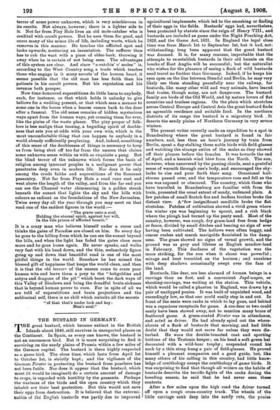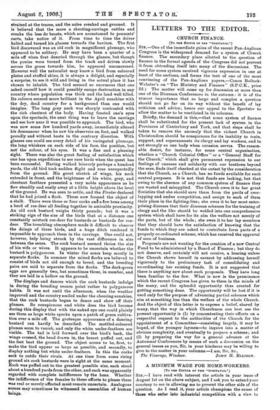THE BUSTARD IN GERMANY.
THEgreat bustard, which became extinct in the British Islands about 1840, still survives in unexpected places on the Continent. In Spain, as every one knows, the bustard is not an uncommon bird. But it is more surprising to find it surviving on the sandy plains of Prussia within a few miles of the German capital. The bustard is there highly respected as a game bird. The close time, which lasts from April let to October 1st, is strictly kept ; and the vigilance of the German Forster in protecting the bustard from poachers has not been futile. Nor does it appear that the bustard, which must (it would be imagined) do a certain amount of damage to crops, is regarded with hostility by the peasants. Perhaps the wariness of the birds and the open country which they inhabit are their best protection. But this would not save their eggs from destruction. It is believed that the extermi- nation of the English bustards was partly due to improved
agricultural implements, which led to the smashing or finding of their eggs in the fields. Bustards' eggs had, nevertheless, been protected by statute since the reign of Henry VIII., and bustards are included as game under the Night Poaching Act, 1828, and the Game Act, 1831. In England the legal close
time was from March 1st to September 1st, but it had, not- withstanding, long been apparent that the great bustard was doomed. It is, for many reasons, improbable that the attempts to re-establish bustards in their old haunts on the brecks of East Anglia will be successful; but the naturalist who wishes for the pleasure of seeing a flock of wild bustards need travel no further than Germany. Indeed, if he keeps his eyes open on the line between Stendal and Berlin, he may very likely see them standing peacefully near the railway, for bustards, like many other wild and wary animals, have learnt that trains, though noisy, are not dangerous. The bustard family are birds of the Old World, and by nature lovers of fiat countries and treeless regions. On the plain which stretches across Central Europe and Central Asia the great bustard finds an agreeable residence and suitable food. In the northern districts of its range the busta.rd is a migratory bird. . It deserts the sandy plains of Northern Germany in very severe winters.
The present writer recently made an expedition to a spot in Brandenburg where the great bustard is found in fair numbers, and, less than an hour's journey by train from Berlin, spent a day stalking these noble birds with field-glasses and watching the strange antics of the males as they showed off their plumes before the females. It was towards the end of April, and a keenish wind blew from the North. The sun, however, when uncovered by the passing clouds, sent a grateful sense of warmth through one's body, and encouraged the sky- larks to rise and pour forth their song. Occasional hail- storms passed over, and the temperature rose and fell as the sun was exposed or obscured. The country, which those who have travelled in Brandenburg are familiar with from the train, presented the usual extent of sandy, unfenced plain. A few patches of small Scotch firs and. leafless birches broke the distant view. A•few insignificant sandhills broke the flat stretches. Patches of cultivation showed a vivid green where the winter rye was beginning to sprout, and a rich black where the plough had turned up the peaty sand. Most of the country, however, was rough, dry grass-land free from hedge or fence, divided by small ditches and bearing no sign of ever having been cultivated. The hollows were often boggy, and coarse rushes and marsh marigolds flourished in the damp- ness. The grass showed no signs of vernal growth, and the ground was as grey and lifeless as English meadow-land. in February. This deadness of the vegetation was the more striking, for the sun when it shone was powerful ; mirage and heat trembled on the horizon ; and sunshine with deep shadows occasionally swept over the face of the land.
Bustards, like deer, are less alarmed of human beings in a carriage than on foot, and a convenient .Tagd.wagen, or shooting-carriage, was waiting at the station. This vehicle, which would be called a phaeton in England, was drawn by a pair of unclipped ponies. It was built of unpainted wood, and exceedingly low, so that one could easily step in and out. In front of the seats were racks in which to lay guns, and behind was a capacious receptacle for game. A roe-deer or two could easily have been stowed away, not to mention many brace of feathered game. A green-coated Forster was in attendance, and acted as driver. He had already spied out the where- abouts of a flock of bustards that morning, and had little doubt that they would not move far unless they were dis- turbed. He wore the double-breasted coat and sporting buttons of the Teutonic keeper; on his head a soft green hat decorated with a wild-boar trophy ; suspended round his neck by a thin strap hung a pair of field-glasses. He proved himself a pleasant companion and a good guide, but, like many others of his calling in this country, had little know- ledge of ornithology except the ornithology of game birds. It was surprising to find that though all writers on the habits of bustards describe the terrific fights of the cocks during the breeding season, he said that he bad never seen these contests.
After a few miles upon the high road the driver turned off upon a rough cross-country track. The wheels of the little carriage sank' deep into the sandy ruts, the pOnies strained at the traces, and the axles creaked and groaned. It is believed that the more a shooting-carriage rattles and creaks the less do beasts, which are accustomed to peasants' carts, take notice of it. From time to time the driver halted and turned his glasses towards the horizon. The first bird discovered was an old cock in magnificent plumage, who appeared to be solitary. He may have been a quarter of a mile off when first descried through the glasses, but though the ponies were turned from the track and driven slowly across the grass towards him, be appeared unconcerned. However well the naturalist may know a bird from coloured plates and stuffed skins, it is always a delight, and especially a surprise, to see it wild and living in the actual place it has chosen to inhabit. The bird seemed so enormous that one asked oneself how it could possibly escape destruction in any country where population was thick and the land well tilled. Its colours seemed more brilliant in the April sunshine with the dry, dead country for a background than one would imagine. The long grey neck was sharply contrasted with the rich chestnut of the body. Having feasted one's eyes upon the spectacle, the next thing was to leave the carriage and see how near it was possible to approach. The bird, who was now some few hundred yards away, immediately altered his demeanour when he saw his observers on foot, and walked proudly and without haste in the contrary direction. With glasses one could see every detail of his variegated plumage, the long whiskers on each side of his face, the position, but not the colour, of his eyes. It was a fine and a pleasing sight: There was also the great feeling of satisfaction which one has upon expeditions to see rare birds when the quest has been successful. Having walked leisurely perhaps a hundred yards, the old bird took sudden flight and rose unexpectedly from the ground. His great stretch of wings, his neck extended in front, and the brightness of his white, grey, and chestnut feathers presented a very noble appearance as he flew steadily and easily away at a little height above the level of the ground. He was seen to settle, and the Forster declared that he had joined a flock. These now formed the object of a stalk. There were three or four cocks ana a few hens among a herd of roe-deer all feeding together in amicable proximity. An old cock bustard weighs thirty pounds; but it was a striking sign of the size of the birds that at a distance one constantly mistook roe-deer for bustards or bustards for roe- deer. The trembling atmosphere made it difficult to observe the doings of these birds, and a huge ditch rendered it impossible to approach them in the carriage. One could not, however, help being struck by the vast difference in size between the sexes. The cock bustard seemed thrice the size of his wife or wives. It appears to be uncertain whether the bustard is polygamous. In winter the sexes keep mostly in separate flocks. In summer the mixed flocks are believed to consist of birds not old enough to breed, and the breeding pairs are said to separate from the flocks. The dark-green eggs are generally two, but sometimes three, in number, and they are laid in a hollow on the ground.
The displays and dances which the cock bustards indulge in during the breeding season point 'rather to polygamous habits. It was not until the afternoon, when the weather improved and the country smiled under the cheering sunshine, that the cock bustards began to dance and show off their plumes. So conspicuous and white does the bird become during this display that with the naked eye one could plainly see them as large white specks upon a patch of green cultiva- tion over a mile off. The grotesque appearance of a dancing bustard can hardly be described. The mottled-coloured plumes seem to vanish, and only the white under-feathers are visible. The tail is laid forward over the bird's back, the wings crossed, the head drawn in, the breast puffed out, and the feet beat the ground. The object seems to be, first, to make the bird appear as large as possible, and secondly, to display nothing but white under-feathers. In this the cocks seek to outdo their rivals. At one time from some rising ground six cock bustards were in sight at the same moment. Each was puffed out to the greatest possible 'size, each stood about a hundred yards from the other, and each was apparently regarded with complete indifference by the hens. Whether the indifference of the females to these efforts to please them was real or merely affected mist remain uncertain. Analogous scenes may sometimes be witnessed in assemblies of human beings.



































 Previous page
Previous page